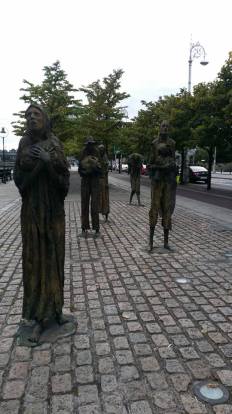
I visited Kerry recently , a stunningly beautiful part of the world. One set of my maternal great great grandparents, Patrick and Mary Connor, came from Killarney to South Australia in 1840. They arrived on the Mary Dugdale as part of of an immigration scheme which selected sober and hardworking labourers and their families for free passage. The scheme was seen as a way of landlords ridding themselves of excess tenants and of providing labour for the larger South Australian landholders. It was believed that eventually these immigrants would have the opportunity of owning land themselves. This was pretty much the pattern that Patrick and Mary followed. Initially they lived in the Thebarton area of Adelaide then, around 1848, moved to rural Saddleworth. In 1858 Patrick acquired 70 acres in the Pine Creek area between Saddleworth and Auburn.
When we left Killarney, looking at the green hills and the roadside fuschia and montbretia, I wondered how Patrick and Mary felt as they left. The beauty of the countryside explains the longing in so many Irish immigrant songs. No doubt they hoped for a better future for themselves and their children, better than they would have in Ireland. Settler life was not easy and, as well as the struggle to make their way in raw developing society, they must have found the hot dry climate a challenge. But they established themselves and eventually had a farm of their own. Patrick and Mary’s only son William (my great grandfather, born 1847 at Thebarton) took over the farm following Patrick’s death in 1865. William sold the farm prior to 1880 when he married and moved to Victoria, taking up a farm of 541 acres at Valencia Creek in Gippsland. That farm remained in the family until 1975. How many sons of labourers in Ireland ended up in that position? Yet the O’Connor (sometime soon after arrival in Australia they acquired an O) story is by no means unique for Irish immigrants to Australia.
Apart from the desire for a better life, families brought with them a cultural heritage of songs, stories, faith and even approach to life. I was surprised when we were listening to an Irish band playing in O’Donoghue’s pub in Killarney that I knew most of the songs well enough to sing along with the rest. As a child I had heard many of these sung by both my proudly Australian mother and grandfather. There is even a linguistic heritage of which I was unaware until quite recently when I read Hidden Ireland in Victoria by Val Noone. (2012) which examines the history of the Irish language and Gaelic culture in Victoria which resulted from migration. This is the cleft sentence, in essence a complex sentence that that has a meaning that could be expressed by a simple sentence. This formation is found in Irish Gaelic. My grandfather and my mother used this in English, and I do at times too. For example, instead of saying ‘She bought a new coat yesterday’, my mother would say ‘It was a new coat she bought yesterday’. I thought this was just a muddled way of speaking – getting the pertinent facts out then realizing that the listener might need more information to understand. It is possible, though, that it is a lingering influence of the Irish language spoken by our forebears. Interesting, too, is the fact that the Famine was always referred to as the Great Hunger, the transliteration of the Irish, an Gorta Mór. I suspect, though, that the Irish influence in language did not come through the O’Connors but rather from the McGraths, my mother’s father’s family. The O’Connors migrated before the Hunger but the McGraths from Upperchurch, Tipperary, did not arrived until 1854. They were a far more politicized family, not doubt partly as a result of having lived though that ultimate cruelty of landlords and politicians standing by, exporting grain, while a million died with nothing but grass in their bellies. 
‘Famine’ (1997)
Custom House Quay, Dublin
dedicated to those Irish people forced to emigrate during the Great Hunger
______________________________________________________________________
©Catherine Anne Merrick
Pingback: Some Family History | Catherine Meyrick